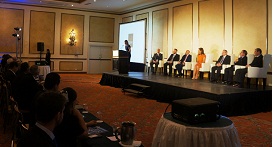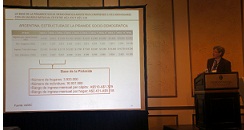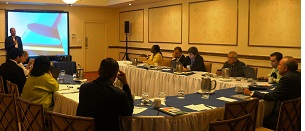More than 350 representatives of the public and private sector came together from July 23-26 for the 1st Regional Telecommunications Conference. Participants included state ministers, regulators and high-ranking mobile network operators from across Latin America. Delegates hailed from 21 countries in Latin America, the Caribbean, Spain and the United States. They converged upon Playa Bonita to analyze and debate the principal issues in the ICT sector and to work together in order to find a way to overcome the digital gap in Latin America.
 On Tuesday, August 23, the conference got started with the meeting of the Regulatory World Group (REGU) of GSMA Latin America. Participants at the meeting discussed key regulatory issues of the different aspects of the mobile industry such as service quality, privacy, license renewal, mobile broadband and its social impact. The group’s participants included representatives from 17 wireless carriers in Latin America. Together, they went over the key issues of the regulatory agenda of network operators in some 11 countries in the region.
On Tuesday, August 23, the conference got started with the meeting of the Regulatory World Group (REGU) of GSMA Latin America. Participants at the meeting discussed key regulatory issues of the different aspects of the mobile industry such as service quality, privacy, license renewal, mobile broadband and its social impact. The group’s participants included representatives from 17 wireless carriers in Latin America. Together, they went over the key issues of the regulatory agenda of network operators in some 11 countries in the region.
The main conference event took place on Wednesday the 24th and Thursday the 25th when all participants came together at the 1st Latin American Telecommunications Conference. The following individuals all attended the inaugural event: Zelmar Rodríguez Crespo, General Manager of the Public Services Authority of Panama; Eduardo Jaén, General Manager of the National Authority for Government Innovation of Panama; Bruno Ramos, Regional Director of the Americas for the ITU; Antonio García Zaballos, leading telecommunications specialist of the IDB; Roberto Blois, President of AHCIET; and Sebastián Cabello, Director of GSMA Latin America.
 During the conference, two studies were presented: “Mobile broadband at the base of the pyramid in Latin America” by Dr. Raúl Katz (Telecom Advisory Services) and “Renovation of use permits for the radio spectrum in Latin America” by Juan Ignacio Crosta, Director of BlueNote Management Consulting. Both studies were commissioned by GSMA Latin America.
During the conference, two studies were presented: “Mobile broadband at the base of the pyramid in Latin America” by Dr. Raúl Katz (Telecom Advisory Services) and “Renovation of use permits for the radio spectrum in Latin America” by Juan Ignacio Crosta, Director of BlueNote Management Consulting. Both studies were commissioned by GSMA Latin America.
Some of the other Latin American government officials in attendance at the Regional Telecommunications Conference include:
- Diego Molano Vega, Minister of Information and Communications Technology of Colombia
- Pedro Pablo Errázuriz, Minister of Transportation and Telecommunications of Chile
- Álvaro Armijos, Vice-Minister of Telecommunications and the Information Society of Ecuador
- Julian Robinson, Minister of Science, Technology and Energy of Jamaica
- Rowland Espinosa Howell, Vice-Minister of Telecommunications of Costa Rica
- Raul Perez-Reyes Espejo, Vice-Minister of Communications of Peru
- Bernardo Lorenzo, President of the Telecommunications Market Commission of Spain
- Mony de Swaan, President of the Federal Telecommunications Commission of Mexico (COFETEL)
- Byron Patricio Vasconez, National Secretary of Telecommunications of Ecuador
- Edwin Castillo, National Director of Telecommunications ASEP, Panama
“Telecommunications are critical to solving the problems we face in Latin America: poverty and inequality. When we are able to get a child from a poor rural area connected to Internet, that child has the same opportunities as children from a higher income family in the capital city. That is a big step towards closing the digital gap. Without a doubt, it is important to continue discussing how to bring connectivity to the base of the pyramid in Latin America,” said the Colombian ICT Minister.
Chilean Minister Errázuriz agreed: “ICTs are one of the strongest tools we have to effect change. They can help us eradicate poverty and provide more equal opportunities to the lower socioeconomic levels. In this regard, it is about providing access and education to make these changes sustainable. We are all working towards the same goal: closing the digital gap.”
One of the activities held on July 25th was a workshop organized by GSMA Latin America in conjunction with the IDB and the ITU. The workshop, which addressed the analog blackout and the ecosystem of the APT 700MHz band plan, included presentations by the organizers and by representatives from Plum Consulting, Alcatel-Lucent, Ericsson and Qualcomm.
The Regional Telecommunications Conference was organized by GSMA Latin America; the Ibero-American Association of Research Centers and Telecommunications firms (AHCIET); the Panamanian government, which was represented by the National Services Agency (ASEP); the Inter-American Development Bank (IDB); the Economic Commission for Latin America (ECLA), eLAC 2015, INTEL, the International Telecommunication Union (ITU) of the United Nations; the Latin American Forum of Telecommunications Regulatory Bodies (REGULATEL), LACNIC and the Internet Society, with the collaboration of the Central American Telecoms Commission (COMTELCA), the United Nations Global Compact, the Secretary General of the Ibero-American Cooperation Department (SEGIB) and the Organisation for Economic Co-operation and Development (OECD).
The conference was associated with the XXIII Latin American Summit of Presidents and Chiefs of State, which will also be held in Panama in October 2013. In closing, the Declaration of Panama was read. The document addresses the challenge of closing the digital gap by the year 2020.
Global Meeting of International Telecom Associations
 As part of the 1st Regional Telecommunications Conference, the first Global Meeting of International Telecom Associations was also held. This AHCIET-sponsored initiative attracted participants like the Association of Telecommunications Enterprises of the Andean Community (ASETA), the Caribbean Association of National Telecommunication Organizations (CANTO), the European Satellite Operators’ Association (ESOA), the European Telecommunications Network Operators’ Association (ETNO), GSMA LA, the Pacific Telecommunications Council (PTC) and the SAMENA (South Asia, Middle East, North Africa) Telecommunication Council. These are all major telecom associations from across the world, including Latin American, the Caribbean, the U.S., Europe, Africa, Asia and the Middle East. This meeting was also supported by the International Telecom Business Association of Portuguese Speakers (AICEP) and the Telecommunication Industry Association (TIA).
As part of the 1st Regional Telecommunications Conference, the first Global Meeting of International Telecom Associations was also held. This AHCIET-sponsored initiative attracted participants like the Association of Telecommunications Enterprises of the Andean Community (ASETA), the Caribbean Association of National Telecommunication Organizations (CANTO), the European Satellite Operators’ Association (ESOA), the European Telecommunications Network Operators’ Association (ETNO), GSMA LA, the Pacific Telecommunications Council (PTC) and the SAMENA (South Asia, Middle East, North Africa) Telecommunication Council. These are all major telecom associations from across the world, including Latin American, the Caribbean, the U.S., Europe, Africa, Asia and the Middle East. This meeting was also supported by the International Telecom Business Association of Portuguese Speakers (AICEP) and the Telecommunication Industry Association (TIA).
At the meeting, the most important associations from the industry joined forced with wireless carriers from different regions to define areas of common interest for the development of the Information Society. The executives who attended emphasized the importance of the event. All agreed that these meetings are an opportunity to get to know more about the different goals and activities of each association, allowing them to standardize and unify criteria; identify areas of cooperation in affairs that are of common interest; personally get to know the guidelines of each association; and exchange ideas and experiences.
In this regard, the meeting aims to build a long-term alliance between the associations in order to promote the sustainable development of telecommunications in an environment that encourages investment, the development of infrastructure, technological innovation and growth within the sector. The plan is to make this meeting an annual event at the 2014 Regional Telecommunications Conference.